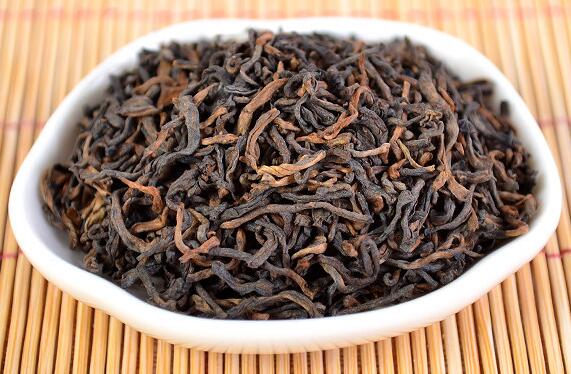Gong Ting (Palace Puer) tea comes from Xishuangbana in the area around old Puer City. The growing area is over 2000 meters above sea level. The tea leaf size is very even and the pluckings were of young leaves and buds; the golden hues are from the buds. The tea color is bright with red overtones. The leaves are bright and brownish red when brewed. There is no flavor of composting and the flavor is rich with a sweet aftertaste. The tea bushes are from 60 to 100 years old. Out of one ton of mao cha, only 30 to 60 kilos will be used for this tea after sorting. This tea is good for people who are new to puer. It is very approachable because it is rich with no bitterness.
Unlike green or white teas, which use the youngest buds and leaves to make the most sought-after grades, the most popular grades of puer tea are the middle to large size leaves. Yunnan tea makers in the late Ming and Qing Dynasties, used younger leaf and bud material to make large compressed "ren tuo cha" — that is "human head" sized balls of tea. The oldest example of compressed puer tea that survives today is one of these ren tuo cha that was gifted to the Qing emperor. It was allegedly the Qing royal family custom to drink Shi Feng Dragon Well green tea in the summer time and fine aged puer tea made from young buds during the winter. The tea was thought to be a necessary compliment to the diet during the dormant winter months.

Tea masters wait for all the mao cha from different regions to be finished processing. All grades of leaves are piled about 80cm high on one side of the factory. About 6-20 tons of tea will be used at a time. The leaves are covered with cotton factory, and sometimes gently sprayed with moisture on the top. The tea will create heat inside, naturally fermenting and growing microbes. Puer factories themselves have rich microbial environments from years of fermenting puer teas. The tea master checks the piles everyday to test the temperature of the tea. Puer factories have their own specific methods of fermentation and cooling down the tea, as to not over-ferment the leaves. Every few days, workers will use large wooden shovels to transfer the tea from one side of the factory to the other.
The leaves stick together during the fermentation process and must be separated for even heat. This re-piling process is repeated over and over again until the leaves eventually turn dark brown. This takes approximately 60 days. The tea master must really control the temperature and moisture that is given to the leaves, depending on the season. Too much moisture will speed up the fermentation process and result in a strong ocean smell. Many cheap puers on the market are made in about 40-50 days. After fermentation process is finished, all of the leaves are dried in an oven. They are then sorted by a machine to sort out the different grades by leaf size. The smallest leaves are 1st grade and the largest are 10th grade.

![Diseases, Symptoms, tcm, [tcmwindow.com]](/uploadFile/adImg/2015/11/11/f5cbfcc0-4df5-4646-9b9a-f316651a0199.jpg)





